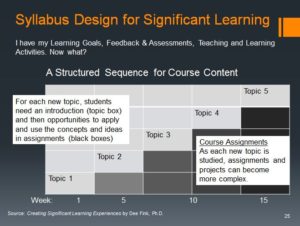gradstep recap: syllabus construction
this blog post is written by dan morrison, a cft graduate teaching fellow. dan led the course & syllabus design session at gradstep on january 21, 2012. you can download the powerpoint andhandouts from this session.
syllabus design: blueprints for learning instead of contracts
 after reviewing the basics of course design in the first half of my gradstep session, i led the group in a process of structuring a course on paper. the major steps are:
after reviewing the basics of course design in the first half of my gradstep session, i led the group in a process of structuring a course on paper. the major steps are:
- divide the semester into 4 to 7 segments; one for each key concept, issue, or topic that are the major foci of the course;
- arrange this material in a logical order. this could be chronologically, by topic or category, from concrete to abstract or vice versa, from theory to application or vice versa, by increasing level of skill or complexity, or in other ways;
- set up your instructional strategy: arrange your teaching and learning activities so that complexity and energy increases and accumulates as students learn each major topic in your course. activities should prepare students for later work; give them opportunities to practice, with prompt feedback, what you expect them to learn to do. you should assess the quality of their performance and allow them to reflect on their learning activities, inside or outside of class.
to help you think about teaching and learning activities, you may employ the “castle top” diagram. this diagram provides you spaces to think about what should happen in class, and what can be done outside that setting. remember to add variety to the types of learning activities throughout each segment of the course. activities and work should gain complexity throughout the course.

string a set of teaching and learning activities together for each of your learning goals, and you have a full instructional strategy. next, sequence these to steadily increase the complexity and challenge in learning from topic to topic. how should the course begin? what activities do you want to finish the course with? what comes in between?
finally, consider grading and course policies. how will you communicate your expectations for classroom behavior, civility, and respect? seek feedback: how will you gather evidence that your course was successful?
this session opened up my eyes to the complexity and challenge of designing courses that result in deep and lasting student learning. i hope that participants were able to think through the ways their courses can be integrated so that students understand how the “story” of their course builds over time. these lessons are not obvious to most students. carefully constructing our courses can lead to engaged, passionate and motivated students. not integrating our courses can lead to complaints that classroom instruction does not match assessments and exams.
dan blogged earlier this week about the first half of this gradstep session which focused on course design.

leave a response